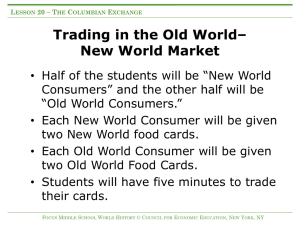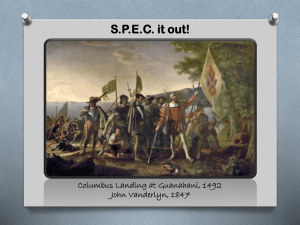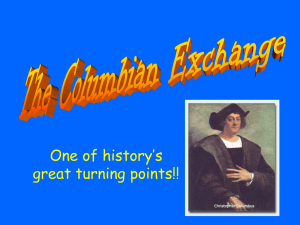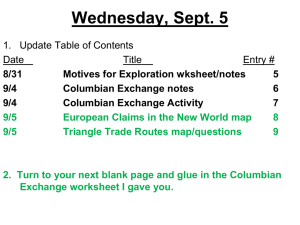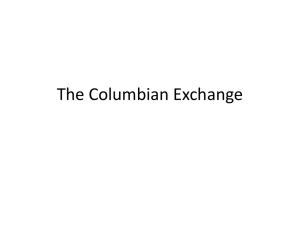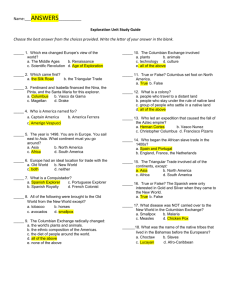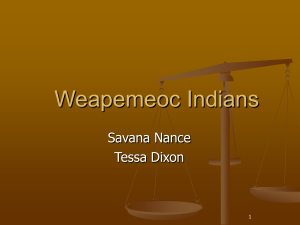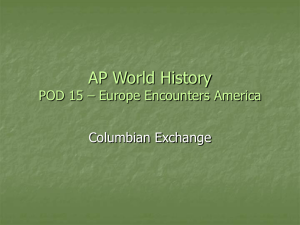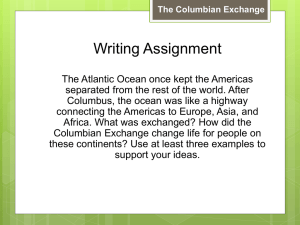Directions
advertisement
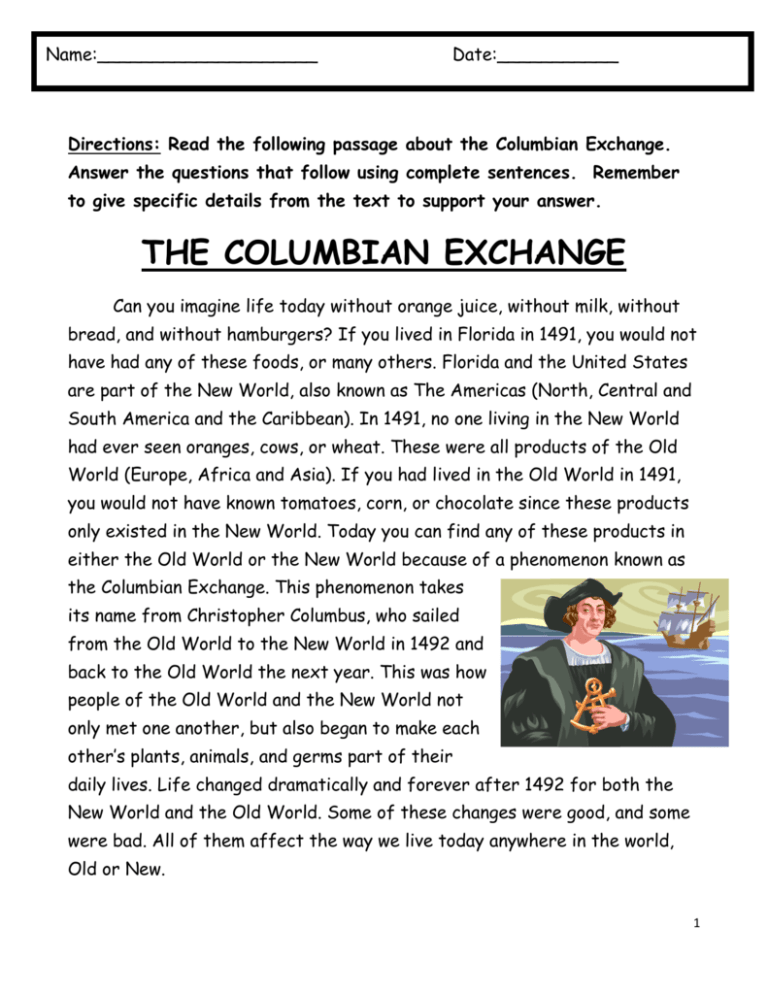
Name:____________________ Date:___________ Directions: Read the following passage about the Columbian Exchange. Answer the questions that follow using complete sentences. Remember to give specific details from the text to support your answer. THE COLUMBIAN EXCHANGE Can you imagine life today without orange juice, without milk, without bread, and without hamburgers? If you lived in Florida in 1491, you would not have had any of these foods, or many others. Florida and the United States are part of the New World, also known as The Americas (North, Central and South America and the Caribbean). In 1491, no one living in the New World had ever seen oranges, cows, or wheat. These were all products of the Old World (Europe, Africa and Asia). If you had lived in the Old World in 1491, you would not have known tomatoes, corn, or chocolate since these products only existed in the New World. Today you can find any of these products in either the Old World or the New World because of a phenomenon known as the Columbian Exchange. This phenomenon takes its name from Christopher Columbus, who sailed from the Old World to the New World in 1492 and back to the Old World the next year. This was how people of the Old World and the New World not only met one another, but also began to make each other’s plants, animals, and germs part of their daily lives. Life changed dramatically and forever after 1492 for both the New World and the Old World. Some of these changes were good, and some were bad. All of them affect the way we live today anywhere in the world, Old or New. 1 The first Old World settlers in The Americas brought horses with them. The New World did not have horses before Christopher Columbus arrived. Just think, if horses had not arrived in The Americas, we would not have had the plains Indians in the North American Southwest, and that in turn, would have prevented us from having popular western movies. Upon returning home, the early explorers and settlers took tomatoes with them that were new to the Old World. Tomatoes were native to The Americas. If tomatoes had not been transferred to the Old World, we may never have had the popular Italian dishes of pizza and lasagna, which are both made with tomato sauce. Perhaps the most dramatic example of The Columbian Exchange at work is the transfer of disease from the Old World to the New World. Between the late fifteenth and the late seventeenth centuries, about thirty to ninety percent of Native Americans died from diseases such as: chicken pox, malaria, measles, pneumonia, scarlet fever, smallpox, and typhus. Before the Spanish explorers came to the New World, Native Americans had none of these diseases. People in the Old World, however, had suffered and died from these diseases for many centuries. As time went on, these diseases remained deadly in the Old World, but some people in the Old World built up a natural immunity to some or all of these diseases, having suffered and survived them in the past. Native Americans did not have this biological resistance, making these diseases far more deadly in the New World. They had never been exposed to these diseases and the onset of them in the New World was devastating. Many Native Americans died from the exposure of these diseases. This natural immunity is seen today. A 2 present-day example of this is chicken pox. People may get sick with chicken pox early in their lives, but they will rarely die from it. After being inflicted, most will develop a biological resistance to the disease. Two major consequences resulted from the transfer of Old World diseases to the New World. First, the Columbian Exchange made the Spanish Conquest of the New World much easier. The Spaniards were able to take over large empires, such as the Aztec of Mexico and the Inca of Peru. The odds seemed against the Spaniards because both empires far outnumbered them. However, disease killed off and weakened Native Americans, making military and political resistance much more difficult. In addition, conquests led to the mixing of the people of the Old and New Worlds. After the conquest, many Native American women had children with the early Spanish explorers from the Old World. Children of Spanish and Native American parents were The history and culture of both the Old World and The New World have been influenced greatly by plants and animals. Unlike disease, their introduction has been deliberate. Bread and wine were part of the Spaniards’ daily diet. Moreover, the Spaniards were Catholic and were required to take bread and wine as part of their Holy Communion. The New World did not have wheat to make bread, or grapes to make wine. The early Spanish explorers and settlers brought the seeds from Spain. Today, wheat is a staple of the American diet and excellent wines are produced in Argentina, California, and Chile. Sugar was introduced to the New World in the same way. Spaniards were also accustomed to riding horses, eating beef, goat and pork, and 3 wearing clothes made from wool. These habits led to the importation of cows, goats, horses, pigs, and sheep. Traditionally, these animals were domesticated, but oftentimes they reproduced in the wild. An example of this is on the Argentine Pampas, where cattle reproduced quickly and continue to do so. To this day, cattle ranching is an important industry in Argentina. This was also the case in the North American Southwest, where wild horses reproduced rapidly. Eventually, the Apache domesticated them. The Apache became formidable warriors, due to the mobility the horses gave them. This proved to be very important to the Apache, as early American settlers in the United States moved westward in the nineteenth century. The Columbian Exchange has had an equally profound influence on the Old World and indeed on the entire world. As one studies history, one can see how quickly the New World grew as immigration from the Old World took place at a rapid pace. One might wonder why the population in the Old World did not decrease, if so many people were leaving the Old World to join those in the New World. The answer to this mystery is “New World crops.” New World crops such as: beans, corn, manioc, and potatoes, grew remarkably well in the Old World. In fact, the Old World found that many of these crops grew far better than the traditional crops that had been raised for centuries by Old World farmers, because the soil proved to be better suited for the new seeds from the New World. The Old World welcomed these new crops. The Columbian Exchange greatly increased the food supply in the Old World. An increased food supply, in turn, increased the human reproductive rate. More food meant more people survived to the reproductive age, thereby increasing the population in the Old World. The population increased swiftly enough so that immigration to the New World did not reduce the 4 population in the Old World. Both Africa and Ireland are good examples of how The Columbian Exchange moved the world. Because of the potato, the population in Ireland grew overwhelmingly. Also, from 1650-1850, the world’s population doubled. In less than half that time, from 1754-1845, the population of Ireland boomed from 3.2 million to 8.2 million. If one considers the two million Irishmen who immigrated to the United States during this time, the population explosion is even more impressive. However, in 1846, life in Ireland took a dramatic turn. The “potato blight” hit Ireland, devastated the potato crops, and left millions of people starving. The examples presented clearly show how The Columbian Exchange transformed the demography of the world. It indeed made possible many historical events and trends. Little did Christopher Columbus know what an influence he would have on the world for centuries to come. Columbus not only showed humankind that the world was larger than imagined, but he also showed that it was smaller at the same time. The Columbian Exchange has permanently transformed the world, making it a more homogenous place. This phenomenon influences even small details of our daily lives. No other event has had such a widespread and lasting effect on the life of humankind and on the life of this planet. 5 Name:____________________ Date:___________ Directions: Using the reading titled “Columbian Exchange”, answer the following questions using specific details from the text. 1. Describe how the Columbian Exchange impacted the New World. 2. Describe how the Columbian Exchange impacted the Old World. 3. How did the Columbian Exchange make the Spanish conquest of the New World easier? 6 4. How does the Columbian Exchange impact your daily life? 5. “Life changed dramatically and forever after 1492 for both the New World and the Old World. Some of these changes were good, and some were bad.” Explain the meaning of the quotation. 7
